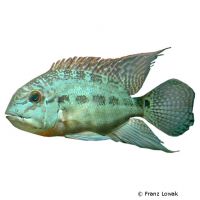True Parrot Cichlid (Hoplarchus psittacus)
| True Parrot Cichlid Hoplarchus psittacus | |
|---|---|
| Name | True Parrot Cichlid |
| Name Lat. | Hoplarchus psittacus |
| Synonym | Heros psittacus |
| Family | Cichlids |
| Family lat. | Cichlidae |
| Order | Cichlids |
| Order lat. | Cichliformes |
| Origin | South America |
| Habitat | Rivers, lakes |
| Diet | Carnivore |
| pH | 5.5-6.5 |
| Behavior | Semi-aggressive |
| Keeping | Pair, group |
| Care Level | Moderate |
| Reproduction | Substrate spawner |
| Breeding | Moderately difficult |
| Life Span | 8-10 years |
| Protection | No |
| Metric Units | |
| Size | 32-35 cm |
| Temperature | 25-29 °C |
| Hardness | 2-10 °dH |
| Aquarium | 700 l |
| US Units | |
| Size | 13"-14" |
| Temperature | 77-84 °F |
| Hardness | 36-178 ppm |
| Aquarium | 200 gal |
Distribution and habitat
The distribution area of the parrot cichlids is in the catchment area of the Amazon and in the tributaries of the upper Orinoco in Colombia and Brazil. They live in calm, shallow watercourses and ponds with soft mud and sandy bottoms
Maintenance
The aquarium should have a robust border planting, structured with roots, branches and stones, which provide numerous hiding places and free swimming space. A deep, dark, sandy substrate, some subdued light (floating plants), soft, acidic water and a weak current is ideal.
No ammonia, ammonium and nitrite should be detectable, and the nitrate value should not exceed 100 mg/l. To ensure the water quality and oxygen content, a filter and heater adapted to the aquarium size is required, as well as lighting for the species-appropriate day-night rhythm of the animals.
Diet
They need strong live food, such as snails, mussels, earthworms, mosquito larvae, shrimps, crayfish and fish, which is also accepted without problems in frozen form, plus commercially available, frozen special food mixtures as well as high-quality dry food for cichlids (sticks, pellets, granules).
Regular and varied feeding promotes health and prevents deficiency symptoms. Only as much should be fed as is eaten immediately (in a maximum of 10 minutes).
Behaviour and compatibility
They should be kept in pairs. Keeping them in groups is only possible in larger, richly structured tanks. They are peaceful, calm animals, which behave territorially only during the spawning season and they should be socialized only with other calm and large fish
Basically, only compatible fish species with similar demands on water condition and water temperature should be socialized.
Sex dimorphism
The sexes are difficult to distinguish. Different coloration of the animals is not an indication of sex. A reliable distinction can only be made during mating, by the genital papilla of the female
Reproduction and breeding
The female spawns on a cleaned stone protected from above (open brooder). The parents perform brood care and defend the clutch (several hundred eggs). After 3-4 days, the fry hatch and are housed in a depression dug by the parents. The school of fry is guarded for some time and led to the feeding places in the aquarium before the brood care ends.
Fry must be fed several times a day with special rearing food (Artemia, Cyclops). In a community tank breeding is hardly possible, because the fry are easy prey.
Important
The breeding of parrot cichlids has so far succeeded only very rarely.
The well-being of the fish should be checked regularly. The temperature should be checked daily, the pH, hardness and nitrate value at least every 14 days. A regular partial water change is recommended, even if the pollutant load has not yet reached the upper limit. Sudden changes in water quality should be avoided. Newly introduced fish must be accustomed slowly to the water in the aquarium.
Further literature can be found in your pet store.
References
Text: petdata; Image: Franz Lowak
Source: BMELV (1998): Tierschutzgutachten - Haltung von Zierfischen (Süßwasser); BAENSCH & RIEHL (2006): Aquarien Atlas Bd. 2, Mergus Verlag; ENGELMANN (2005): Zootierhaltung - Tiere in menschlicher Obhut: Fische, Verlag Harri Deutsch
- Gemäß § 21 Abs. 5 Tierschutzgesetz idgF
